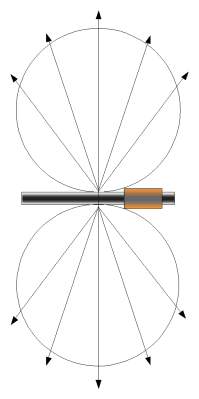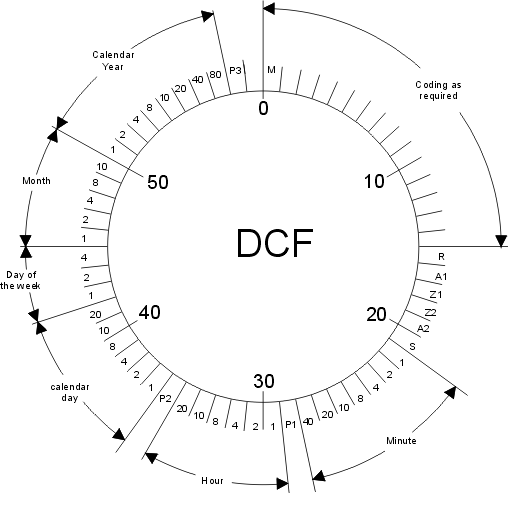|
|
||||||||||||||||||||||||||||||||||||||||||||||||||||||||||||||||||||||||||||||||||||||||||||||||||||||||||||||||||||||||||||||||||||||||||||
| Home | News | Products | Service | Technology | Customer Area | Downloads | Links | Contact | ||||||||||||||||||||||||||||||||||||||||||||||||||||||||||||||||||||||||||||||||||||||||||||||||||||||||||||||||||||||||||||||||||||||||||||
| > Technology > Technology - Antenna Design | ||||||||||||||||||||||||||||||||||||||||||||||||||||||||||||||||||||||||||||||||||||||||||||||||||||||||||||||||||||||||||||||||||||||||||||
|
NEW ! Antenna Calculator NEW !
In most cases the design of a radio controlled clock receiver will determine the dimensions of the required receiving aerial for the low frequency band, because the prescribed dimensions must not be exceeded. Usually the aerials work according to the principle of a magnetic dipole, their size can be reduced largely by insertion of a ferromagnetic material. Compared to the antennas for reception of the electrical field the magnetical aerials have the advantage that - regarding the frequency range of interest - they can be easily matched to the input circuit of the receiver. By completion with a parallel-connected capacitor a parallel resonant circuit is originated, which can be tuned to resonance and which allows to adjust noise or impedance matching. Herewith the voltage of the antenna input circuit, which is induced in the antenna coil by the electromagnetic field of the transmitter, is increased with the quality factor Q. It is presumed, that the input impedance of the receiver is high - like that of the integrated circuits T4223B and CME6005 manufactured by ATMEL Germany. The terminal voltage of the ferrite aerial is determined by several parameters. It can be calculated with the following formula:
with: The discussion of formula (1) shows, that:
Additionally it should be mentioned that the selectivity
of the antenna circuit increases with a raising quality factor Q,
which improves the noise immunity regarding reception on
adjacent frequencies due to reducing the bandwidth. For those applications special antenna designs have to be used, which provide an elliptical or omni directional receiving characteristic. The latter can only be achieved with rod aerials. More detailed explanations can be found in the relevant patent literature e.g. DE 3504 660 C2, DE 37 01 378 C2. Generally it is to state, that - to consider the worst case - noise matching should be the target, due to the low field strength's that must be expected. Thus the most essential criteria for the electrical dimensioning of the antenna is fixed. The optimal generator resistance of the input circuit, for a tuned antenna this is their resonant resistance, is approximately 180kΩ to 300kΩ for the high resistance receiver T4223 / U4223 and about 50 kΩ to 100 kΩ for the CME6005. The optimal value is not easy to determine, as the matching curve shape is rather flat. This means that a rather large range for the nearly optimal resonant resistance can be permitted. In the frequency range of interest the required resonant resistance can be realised by adequate dimensioning of the antenna circuit. For two reasons it has turned out to be suitable to set the dimensioning to the low-resistive range of the noise-matching curve. Firstly the required quality factors are easier to achieve and secondly the feedback is reduced.
The input impedance of the integrated circuit is neglected. It is high compared to the required generator resistance for optimal noise matching. To reduce feedback the resonant resistance of the antenna circuit shall be set to Rres = 180 kΩ for the U4223. A quality factor of 100 is realistic and can be achieved without special efforts. The circuit capacitance can be calculated for f= 77,5 kHz (German DCF) as follows (example for the 180 kΩ Antenna):
The standard value close to it is: C = 1,2 nF
The bandwidth is calculated with:
If the loss resistance of the capacitor is neglected, the following formula is valid:
Due to the very small bandwidth of the input circuit exact temperature compensation is essential. For the same reason the aerial must be tuned to resonance with the received time signal transmitter at the actual mounting position. Please note that e.g. metallic objects close to the antenna will influence the alignment and may lead to the necessity of corrections. Formula (2) can also be used to calculate the resonant resistance Rres if the capacitance is known and the bandwidth Δf is measured. To avoid any influence of components used for coupling between signal generator and antenna, the signal generator should be equipped with a loop antenna for this measurement. The probe that is used to measure the antenna voltage should be an active one. Its resistance must be high compared to the resonant resistance of the antenna and its capacitance must be very small compared to the capacitance of the antenna circuit, so that neither the quality factor nor the resonance frequency of the antenna are influenced in a significant way. This calculation can also be done for the CME6005 with the 40 to 100 kΩ Antenna resonant resistance.
The input stage of the integrated receiver circuit is designed as a differential
amplifier. The input transistors must be biased externally in case of
the U4223, the CME6005 has in build biasing resistors of 200 kΩ.
In the case of U4223 three different input circuits are possible, as figured
out in the following circuit diagrams. Please note: the CME6005
can only use a single ended antenna, because of it's in-build biasing
resistors (Fig. 1 d).
A single-ended antenna requires less expenditure. Different connections of the aerial
For the U4223 the variation c) is proposed because of the benefits of a balanced connection, while the expenditure for a tapped coil is avoided. The two resistors used to bias the input transistors should be high resistive to conserve the quality factor of the antenna.
Also the ferrite material has an influence to the quality of the antenna. The user is hold to select a material with excellent behaviour in the frequency range from 20 to 120 kHz in order to reduce losses from the ferrite material. (See also section practical antenna design)
For the following comparison different aerials were connected to a demo board of the U4223. An RF generator was modulated with the time signals according to the coding of the German DCF77 transmitter. The generator output was fed to a loop antenna, while the investigated receiving antennas were placed in the axis of the loop antenna at a defined distance. The receiver boards were connected with a data processing unit to decode the time information. The sensitivity was defined by the correct decoding of at least two data telegrams out of four. All measurements were carried out in a shielded room (faraday cage) to avoid failures caused by external disturbing sources. Nevertheless the reproducibility of these measurements is critical. Field distortions inside the shielded room may have an influence; therefore the following results should be regarded only as a rough guideline for own antenna developments. The sensitivities are referred to antenna No. 1. The antennas designed for the use with U4223.
It can be clearly seen, that the antenna can increase the system sensitivity significantly if the antenna is designed in the right way. More increase of the sensitivity of the system can be achieved by using different diameters of wire or by using multiwire wires.
The antennas useful for time code reception, are ferrite-root antennas. This antennas have always a bi-directional receiving behaviour like a classical dipole antenna. (see Figure) By changing the diameter and the length of the root, the characteristic of the reception behaviour can be influenced somewhat. A bigger diameter and a shorter length leads to a less strong bi-directional reception. This information should be taken into consideration by planing the antenna together with the part in which the antenna should work.
Step 1 The CME6005 is designed to be used with a simply antenna, following
the Figure 1d).
Essential for the Rres is the quality
factor Q and the L/C ratio. For example: we have the resonant frequency of DCF77 = 77500Hz and a bandwidth of 775 Hz, then we use the simple formula coming from (4):
In this case the Q-factor is 100 Step 2 To find the values for the inductance and the capacitance we have to use the formula for a resonant circuit:
Also here we chose a practical value for the capacitance.
Step 3 Now we need to choose the ferrite material in order to calculate our
windings. Step 4 We need now to know the effective permeability (µeff) of the ferrite material. If we cannot get it from the data's from the supplier, we can get the value easy by putting 100 windings onto the ferrite and than testing the inductance. The following formula shows the way how to get this factor:
Step 5 The wire material and the type of doing the windings have an influence
to the quality of the antenna. Step 6 In all cases, the antenna has to be tuned to the desired frequency, because
the ferrite itself as well as the capacitor have some tolerances. The
easiest way is to make the coil movable on the ferrite. The capacitor
has it's best place on the windings or as close as possible to the coil.
A phase-gain analyser is the ideal tool to very quickly find the resonant
point. Now moving the coil on the ferrite varies the resonant frequency
to the desired value e.g. 77500kHz (DCF77).
If all the above mentioned points are taken into account, it is still
good, to do some variations of the antenna in order to find the antenna
with the best result in the specific application.
The quality factor this dimensioning was based on can be achieved only
with high-quality capacitors.
The antenna is mainly sensitive to the magnetic component of the transmitted
frequency. There are a lot of possible external and internal electrical
and magnetically distortions. Thus, close to the antenna any wire with
AC components on it has to be avoided. This is also valid for the output
of the receiver. The receiver is a direct receiver and components from
the output signal, coupled to the antenna by electrical field or parasitic
capacitors, cause a reduction of the sensitivity. The leads of the antenna
has to be shielded or at least twisted to avoid unsymmetrical induction
of noise. Also metal component e.g. batteries, holder for batteries, detune
the antenna and reduce the sensitivity of the system. LCD display have
a extensive field of distortion. This components have to be placed as
fare as possible from the antenna AND receiver. Summarisation:
The time code signal generally has the following format: Each second is 1 bit transmitted. The place of the bit (1 to 59) gives the meaning of the information of this bit. Example:
The signal at the antenna looks like that:
To decode a Time-Code-Signal several principal steps are necessary.
To do the information-decoding, the coding of the transmitter used has to be taken. Examples can be taken out of the datasheet. Please note: The user is responsible to verify the information from the transmitters. If the coding changes, no warning is given from the submitter of the paper.
|
||||||||||||||||||||||||||||||||||||||||||||||||||||||||||||||||||||||||||||||||||||||||||||||||||||||||||||||||||||||||||||||||||||||||||||























